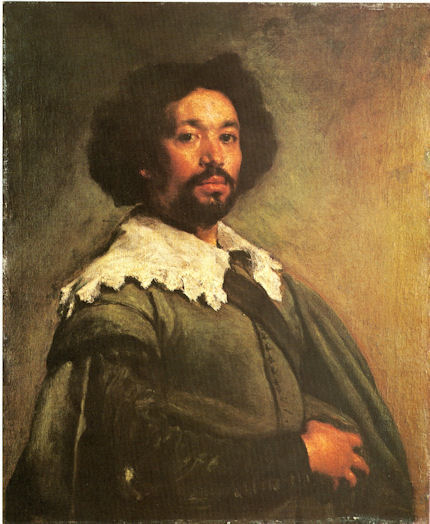
Juan de Pareja was a Spanish painter,described of having brownish colour and of monisco breed meaning mixedrace, born into slavery in Antequera, near Málaga, Spain. He is known primarily as a member of the household and workshop of painter Diego Velázquez, who freed him in 1650. His 1661 work The Calling of Saint Matthew is on display at the Museo del Prado in Madrid, Spain.
The Portrait of Juan de Pareja is a painting by Spanish artist Diego Velázquez of his assistant Juan de Pareja, a notable painter in his own right, who was enslaved and owned by Velázquez at the time the painting was completed. Velázquez painted the portrait in Rome, while traveling in Italy, in 1650. It is the earliest known portrait of a Spanish man of African descent.
In 1649, as court painter to Philip IV of Spain, Diego Velázquez was sent to Rome to purchase works of art for the Alcázar in Madrid. Velázquez brought with him Juan de Pareja, an enslaved man, who served as an assistant in the artist's workshop.
During his stay in Rome, Velázquez executed an oil painting of Juan de Pareja, which was displayed as part of a larger exhibition of paintings at the Pantheon on 19 March 1650. According to Antonio Palomino's biography of Velázquez, the painting "was generally applauded by all the painters from different countries, who said that the other pictures in the show were art but this one alone was 'truth'."
Velázquez painted the portrait of Juan de Pareja, who was a Morisco from the city of Antequera in southern Spain,in his workshop, as an exercise in preparation for his official portrait of Pope Innocent X. The Pope, a ruddy-faced man who would be depicted in the bright pink and crimson robes of his office, presented a tricky study in both color and composition.
Additionally, since he would be executing a portrait from life, Velázquez would be forced to work quickly while still capturing the essence of Innocent X's character. The Portrait of Juan de Pareja reflects Velázquez's exploration of the difficulties he would encounter in the Pope's portrait. To compensate for a restricted palette of colors, Velázquez adopted a loose, almost impressionistic style of brushwork to bring an intense vitality to his subject.
Juan de Pareja (circa 1610 – 1670) became an artist in his own right, and in 1654 he was freed by Velázquez.


